
The 2012-2014 series of civil law workshops explored « Les apparences en droit civil ».
The workshops were presented with financial assistance from Justice Canada’s Support Fund for Access to Justice in Both Official Languages.
Each workshop was accredited for 1.5 hours of continuing legal education by the Barreau du Québec.
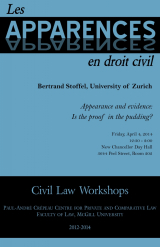 Bertrand Stoffel, University of Zurich: "Appearance and evidence: Is the proof in the pudding?"
Bertrand Stoffel, University of Zurich: "Appearance and evidence: Is the proof in the pudding?"
Friday, April 4, 2014, 12:30-2:00, room 202, New Chancellor Day Hall
Abstract: Appearance plays a major role in civil evidence. Certainly, the judge may sometimes rely on science to prove facts. Often however, the judge will have to base her judgment on what appears to her as true or false.
In private law, proof is the demonstration of an alleged fact. It is the process that will lead the judge to the intimate conviction of the existence of the fact. But what, then, are the criteria for the establishment of such demonstration? To a large extent, the judge will rely on her own experience to establish the existence of a fact. She will review documents, hear statements, and inspect locations. All this will put the fact in evidence: It will make it appear as true or false.
The evidence—or appearance—of a fact will always be provisional. That is to say, no matter how many pieces of evidence are available, one can never be sure that this is exactly how the fact happened. Indeed, to the observer, the fact evidenced will remain an isolated fact. Moreover, the appearance of that fact will be that which the observer, in his own position and with his own experience, will perceive.
This atelier will explore how proof in private law can be a matter of appearance and how it relies on observation and probability. Reliance on observation is not without problems. Observation will disturb the facts, suppressing some of them and putting others in front. In the same vein, the judge will need to base her findings on her experience of life in order to establish the probability of a fact, thus linking proof with considerable uncertainty and subjectivity.
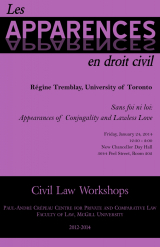 Régine Tremblay, University of Toronto: "Sans foi ni loi: Appearances of Conjugality and Lawless Love"
Régine Tremblay, University of Toronto: "Sans foi ni loi: Appearances of Conjugality and Lawless Love"
Friday, January 24, 2014, 12:30-2:00, room 202, New Chancellor Day Hall
Abstract (In French only): L’auteure propose un survol historique du traitement des conjoints de fait en droit civil québécois. Elle défend qu’hier comme aujourd’hui, la non-reconnaissance de ce type d’unions dans le Code civil du Québec repose davantage sur une désapprobation ancrée dans d’autres ordres normatifs : la religion et l’économie. Cependant, ce type d’unions produit de nombreux effets juridiques en droit privé comme en droit public. Cette situation crée une apparence de conjugalité et ne peut que confondre le justiciable.
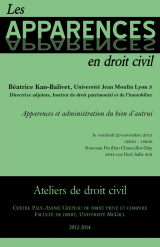 Béatrice Kan-Balivet, Université Jean Moulin Lyon 3, Assistant Director of the Institut de droit patrimonial et de l'immobilier (IDPI): "Apparences et administration du bien d¹autrui"
Béatrice Kan-Balivet, Université Jean Moulin Lyon 3, Assistant Director of the Institut de droit patrimonial et de l'immobilier (IDPI): "Apparences et administration du bien d¹autrui"
Friday, November 29, 2013, 12:30-2:00, room 202, New Chancellor Day Hall
Abstract (in French only): La nécessité de recourir à un tiers pour administrer ses biens est une constante exclusive de toute considération spatiale ou temporelle, exacerbées dans nos sociétés contemporaines par la mondialisation et la mutation des patrimoines. Le droit objectif présente ainsi une gamme étendue de dispositifs pour répondre aux besoins d’un sujet de droit, qui ne veut, ne peut ou ne doit pas administrer ses biens. Les circonstances ayant justifié l’avènement d’une théorie générale de l’administration du bien d’autrui dans le nouveau Code civil québécois sont également présentes en droit français, sans pour autant qu’un tel axe de réflexion ait percé dans le Code civil français, voire au niveau doctrinal. Si le contexte est similaire, le modèle unitaire de la technique avec pouvoir pose interrogation.
La difficile réception de la fiducie dans les pays de la famille romano-germanique invite à nouveau à s’interroger sur les apparences de modèle unitaire de l’administration du bien d’autrui.
La lutte contre les apparences passe par l’établissement d’une différenciation notionnelle des techniques d’administration du bien d’autrui. La technique avec pouvoir dans une acception juridique ne saurait faire oublier les techniques sans pouvoir, lesquelles lui sont antérieures et subsistent en droit positif, même si elles sont plus frustes. La propriété-gestion nécessite en effet un transfert de propriété pour administrer lesdits biens, tandis que l’avancée à consister avec la détention-gestion, à ne remettre ses biens qu’en possession au sens du droit romain, l’administré en conservant la propriété. La différence est sensible, l’administrateur n’est alors plus titulaire d’un pouvoir, mais d’un droit.
Cette différenciation notionnelle n’est pas sans enjeux puisqu’elle induit une différenciation fonctionnelle. Chaque mode de gestion réalise en effet un équilibre propre entre les deux impératifs de gestion que sont, le dynamisme de la gestion et la protection des intérêts en présence. Historiquement, c’est d’ailleurs la prise de conscience de ces fonctions qui explique le déclin ou la « réapparition » de certaines techniques. Selon la technique utilisée, par exemple, l’étendue des prérogatives de l’administrateur ou encore les risques encourus par l’administré ne sont pas les mêmes.
La lutte contre les apparences en matière d’administration du bien d’autrui s’inscrit en conséquence dans une démarche fondamentale avec des enjeux qui ne sont pas seulement théoriques.
 Adrian Popovici, McGill University: "Le mandat apparent"
Adrian Popovici, McGill University: "Le mandat apparent"
Friday, September 20, 2013, 12:30-2:00, room 202, New Chancellor Day Hall
Abstract (in French only): Le mandat apparent est le joyau des phénomènes juridiques que l’on peut regrouper sous le titre de la théorie de l’apparence en droit civil. Un rappel des règles qui le gouvernent et de sa raison d’être peut ouvrir la voie vers d’autres concepts collatéraux encore peu explorés : les contrats fictifs, imposés, présumés, les contrats-sanctions, etc… Tout ça pour stimuler la résurrection du quasi-contrat, nouvelle vague; quasi-contrat réalité ou hérésie?
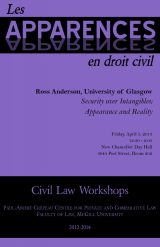 Ross Anderson, University of Glasgow: "Security over Intangibles: Appearance and Reality"
Ross Anderson, University of Glasgow: "Security over Intangibles: Appearance and Reality"
Friday, April 5, 2013, 12:30-2:00, room 202, New Chancellor Day Hall
Abstract: What do incorporeals looks like? Their qualities are substantive, not physical. That is true of all rights in all systems. But civil lawyers, it seems, can see what common lawyers do not. The institutional structure of the civil law – persons, obligations, property – together with general patrimonial principles (such as the numerus clausus, the publicity and specificity principles) means civil lawyers know real rights and limited real rights when they encounter them. The division between real rights and personal rights, inherent in the institutional structure, plays a central role in the law of security interests. It is this simplicity, indeed, that is one of the great attractions of the civil law approach to private law.
Perhaps because of its antiquity, its weight of authority, and relative rationality, however, the basic civilian concepts, particularly in the law of security, are all too readily asserted rather than explained. There has not, in general, been the same critical reflection so characteristic of much modern discourse on proprietary security interests in the common law. Those common law responses, on the whole, demonstrate much practical, if ad hoc, ingenuity. But this ingenuity has not been matched by intelligibility.
Coherence has long been a civil law attribute. But even the great civil codes were not always coherent, particularly on technical points involving ownership and security. The codes were composed at a time when land was the paradigm asset and intangibles were, for commercial purposes, dealt with in the commercial codes and, in particular, in the law of negotiable instruments. The result has been the perception of conservatism. The lack of systematic review has sometimes resulted in only piecemeal amendments. The recent review of moveable security law in Scotland has given one opportunity – in an English speaking system rooted, in this area, in the civil law – for wholesale reflection.
In this context I consider, three points: the theory of limited rights as applied to claims and IPRs; the specificity principle; and the publicity principle. The appearance of civil law coherence is shown to be, in places, illusory. Building on the work of George Gretton, however, I suggest that a more coherent approach to basic patrimonial principles brings a clarity to the structure of the law. And it is these doctrinal improvements that allow us to focus on translating our theory into the reality of ordinary financial transactions.
 Daniel Jutras, McGill University: « Que personne ne bouge! La confiance légitime comme source d’obligations en droit civil »
Daniel Jutras, McGill University: « Que personne ne bouge! La confiance légitime comme source d’obligations en droit civil »
Friday, January 18, 2013, 12:30-2:00, room 202, New Chancellor Day Hall
 Silvia Ferreri, University of Turin: "The Appearance of Ownership: Sale of Another's Property (An Independent Version in Italy)"
Silvia Ferreri, University of Turin: "The Appearance of Ownership: Sale of Another's Property (An Independent Version in Italy)"
Friday, November 16, 2012, 12:30-2:00, room 202, New Chancellor Day Hall
Abstract: The Italian provision corresponding to the French “possession vaut titre” (art. 2279 of the French Code Civil) does not distinguish between stolen or lost goods, and goods entrusted to a person who has failed to keep them in safe custody for the owner (see art. 1153 Italian civil code). This change occurred in 1942, when a new code replaced the previous one, which was a faithful 19th century reproduction of the French Code Napoleon.
There are some explanations for this innovation (which places Italy in an isolated position in comparison with neighbouring countries in Europe): the distinction was not easily enforced in court, many exceptions applied, and it was not soundly established in the Roman tradition. The result is unfortunate: Italy has become a privileged market for stolen goods imported from abroad. Switzerland and Germany still distinguish how the goods left the owner’s possession.
There are at least two interesting international cases to mention: French Ministry of Culture v. Italian Ministry of Culture and De Contessini, Cass. 24th November 1995, n. 12166 and Casa della cultura ecuadoriana c. Danusso, Trib. Torino, March 23°, 1982. They reach opposite results as far as the restitution of an illegally imported good is concerned. Why did the distinction exist previously? We have to go back to the Roman rule (nemo dat quod non habet) and to the competing Germanic rule (Hand wahre Hand): the latter won in the period of the jus commune (prior to the French revolution), and passed into the French codification. But the distinction was never felt strongly in the Romanistic environment, and in 1942 Italy broke away from the rest of the European codifications. Unfortunately the requirement of good faith on the part of the buyer is presumed (according to a specific rule of the Italian code: art. 1147); this puts the burden of proof of the lack of good faith on the shoulders of the plaintiff, and it means that sometimes stolen goods cannot be recovered. There are some further rules to be considered that introduce some safeguards for “cultural goods” and provide some opportunity to recover them: Codice dei Beni Culturali (D.Lgs. 42/2004, art. 64); 1970 UNESCO convention: Convention on the Means of Prohibiting and Preventing the Illicit Import, Export and Transfer of Ownership of Cultural Property (Paris, 1970); UNIDROIT Convention on Stolen or Illegally Exported Cultural Objects, (Rome, 24 June 1995), in force since 1998 (5 ratifications); Council Directive No 93/7/EEC governing the return of cultural objects unlawfully removed from the territory of a Member State; Council Regulation (EC) No 116/2009 laying down provisions on the export of cultural goods.
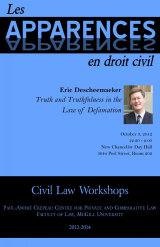 Eric Descheemaeker, University of Edinburgh: "Truth and Truthfulness in the Law of Defamation"
Eric Descheemaeker, University of Edinburgh: "Truth and Truthfulness in the Law of Defamation"
Wednesday, October 3, 2012, 12:30-2:00, room 202, New Chancellor Day Hall
Abstract: This paper provides a comparative overview of two related, but analytically distinct, issues in the law of defamation. The first is whether the true character of a defamatory statement relieves the defendant from liability. On this issue, the civilian and common-law traditions have historically settled on two markedly different stances, the latter accepting the sufficiency of truth simpliciter while the former never did. Some of the reasons for this distinction are explored. Different is the issue of truthfulness, in the sense of belief in truth. Does it, and should it matter, that a defendant believed that what they said was true albeit (prima facie) defamatory? Should we distinguish on the basis of the ‘quality’ of the belief? This paper argues that reasonable truthfulness ought to be recognised as a defence in the law of defamation. De lege lata, the law has never come up with such a general principle, but observation suggests that it has in fact been beating about the bush for a long time, using other analytical tools. Besides, a number of recent developments internationally can be understood as attempts to get closer to the above position.
